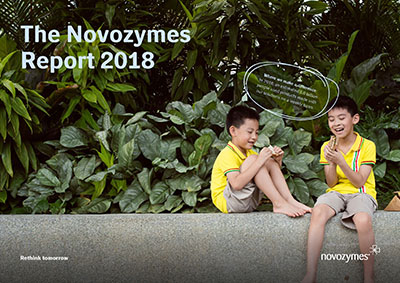Operational ecoefficiency
Novozymes strives to decouple environmental impact from business growth, and aims to define targets and metrics that measure and drive our sustainability performance.
In previous years, we have measured resource efficiency relative to gross profit, but this has proved not to be optimal, as non-sustainability-related changes in gross profit, such as currency fluctuations and product mix, distort the picture of the actual sustainability performance. We have therefore decided to explore a better way of measuring our sustainability performance and aim to finalize this work in 2019.
While exploring better long-term sustainability measures, we have introduced annual targets for energy and water consumption and CO2 emissions, where we aim to keep growth in resource consumption and CO2 emissions lower than our organic sales growthSales growth from existing business, excluding sales from business acquisitions and divestments, measured in local currency..
Climate change
Novozymes’ total CO2 emissions were 472,000 tons in 2018, an increase from 447,000 tons in 2017. Our target measures the increase in part of the total CO2 emissions (scope 1+2 only), which increased by 7% from 408,000 tons in 2017 to 437,000 tons in 2018. This means the target was not met.
Despite this, Novozymes' net overall impact on climate change remains positive, as its products result in lower CO2 emissions over their life cycles compared with conventional technologies. In 2018, our customers avoided an estimated 88 million tons of CO2 emissions by applying our solutions in their products or processes, up from 76 million tons in 2017. This is equivalent to taking 37 million cars off the road.
Energy
In 2018, Novozymes’ energy consumption was 4,831,000 GJ, an increase of 1% compared with 2017. Renewable sourcesThe proportion of the energy used at Novozymes’ sites that consists of continuously replenished energy generated from natural processes. Sources include solar, wind and hydro power-based electricity and energy from biogas. accounted for 23% of the energy consumption in 2018, down from 24% in 2017. All our electricity in Denmark and Brazil comes from offshore windfarms and hydropower.
Water
In 2018, Novozymes’ water consumption increased by 1% from 8,106,000 m3 in 2017 to 8,205,000 m3.
The total volume of wastewater generated in 2018 increased by 2%.
In 2018, Novozymes established a wastewater treatment plant at its new production site in Patalganga, India, designed to reuse 100% of the treated process water in production.
Waste
Novozymes recovered 97% of biomass Organic material, predominantly plants or plant residues. generated in 2018 from landfill, on par with 2017.
For solid waste, the rate of recycling across our global production sites increased to 44%, compared with 43% in 2017.
Environmental compliance
The number of breaches of regulatory limits recorded worldwide increased to 27 in 2018 from 24 in 2017. Most of these breaches relate to wastewater treatment. Novozymes is addressing these incidents. In addition, we received 11 neighbor complaints in 2018, compared with 12 in 2017, mostly related to air pollution and waste management.




